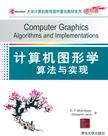计算机图形学
2012-1
清华大学出版社
(印)穆克赫尔吉,(印)贾纳 著
583
《计算机图形学:算法与实现(英文影印版)》是在多年的教学经验基础上,从方便读者接受和理解的角度来编写的,每章先以浅显的语言介绍计算机图形学的算法,然后以丰富的示例阐述计算机图形学基本算法的C++语言实现,这不仅增加了本书趣味性,而且还使本书非常具有的实用性,很多计算机图形学的算法实现代码,读者可以直接应用到自己的编程中,真正做到计算机图形学的算法与实现完美结合,非常适合作为“计算机图形学”课程的教材。
preface xi
1 introduction to windows programming
1.1 prologue
1.2 windows operating system--the universal graphical user
interface
1.3 windows os----intepnals
1.4 windows programming
1.4.1 data type notation
1.4.2 predefined constants
1.4.3 windows programming architecture
1.4.4 creating project in visual studio
1.4.5 other ide and compiler options
1.4.6 message-driven programming
1.5 first windows program
1.5.1 implementation
1.5.2 program description
1.6 typing characters in window
1.6.1 implementation
1.6.2 program description
1.7 my first menu
1.7.1 implementation
1.7.2 program description
1.8 summary
1.9 review questions and exercises
2 two-dimensional geometric transformations 33--
2.1 prologue
2.2 tp. anslation
2.2.1 implementation
2.2.2 program description
2.3 reflection
2.3.1 implementation
2.3.2 program description
2.4 rotation
2.4.1 implementation
2.4.2 program description
2.5 scaling
2.5.1 implementation
2.5.2 program description
2.6 zooming
2.6.1 implementation
2.6.2 program description
2.7 rubber banding
2.7.1 implementation
2.7.2 program description
2.8 summary
2.9 review questions and exercises
3 line drawing algorithms
3.1 prologue
3.2 scm conversion algorithm: a simple line drawing algorithm
3.3 bresenham's scm conversion algorithm
3.3.1 implementation
3.3.2 program description
3.4 bar chart
3.4.1 implementation
3.4.2 program description
3.5 summary
3.6 review questions and exercises
4 circle drawing algorithms
4.1 prologue
4.2 bresenham's circle drawing algorrmm
4.2.1 implementation
4.2.2 program description
4.3 bresenham's ellipse drawing algorithm
4.3.1 implementation
4.3.2 program description
4.4 arc
4.4.1 implementation
4.4.2 program description
4.5 pie chart
4.5.1 implementation
4.5.2 program description
4.6 projected pie implementation
4.6.1 program description
4.7 summary
4.8 review questions and exercises
5 drawing curves
5.1 prologue
5.2 b-spline curve
5.2.1 implementation
5.2.2 program description
5.3 bezier curve
5.3.1 implementation
5.3.2 program description
5.4 summary
5.5 review questions arm exercises
6 filling algorithms
6.1 prologue
6.2 seed fill algorithm
6.2.1 implementation
6.2.2 program description
6.3 scan line polygon fill algorithm
6.3.1 implementation
6.3.2 program description
6.4 summary
6.5 review questions and exercises
7 clipping algorithms
7.1 prologue
7.2 viewport clipping
7.2.1 implementation
7.2.2 program description
7.3 mn)point subdivision line clipping
7.3.1 implementation
7.3.2 program description
7.4 sutherland-cohen line clipping
7.4.1 implementation
7.4.2 program description
7.5 summary
7.6 review questions ant) exercises
8 three-dimensional graphics
8.1 prologue
8.2 3d coordinate system
8.3 displaying 3d objects
8.4 3d transformations
8.4.1 3d translation
8.4.2 3d rotation
8.4.3 3d scaling
8.5 3d object to 2d image projection
8.5.1 worm coordinate to 3d viewpoint-based coordinate
transformation
8.5.2 viewpoint-based coordinate system to 2d image
transformation
8.6 displaying cube in 2d screen
8.6.1 implementation
8.6.2 program description
8.7 displaying sphere in 2d screen
8.7.1 implementation
8.7.2 program description
8.8 viewing transformations
8.9 implementation of other geometric shapes
8.9.1 implementation
8.9.2 program description
8.10 summary
8.11 review questions and exercises
9 hidden surface removal
9.1 prologue
9.2 z-buffer
9.3 z-buffer algorithm for cube
9.3.1 implementation
9.3.2 program description
9.4 z-buffer algorithm for sphere
9.4.1 implementation
9.4.2 program description
9.5 ray tracing
9.6 ray tracing algorithm for cube
9.6.1 implementation
9.6.2 program description
9.7 ray tracing algorithm for sphere
9.7.1 implementation
9.7.2 program description
9.8 summary
9.9 review questions and exercises
10 illumination and shading
10.1 prologue
10.2 illumination
10.3 modelling a shiny surface
10.3.1 phong illumination model
10.4 phong illumination for cube
10.4.1 implementation
10.5 phong illumination for sphere
10.5.1 implementation
10.5.2 program description
10.6 summary
10.7 review questions and exercises
suggested further reading
index
版权页:插图:After installation, the Dev-C++ IDE opens with menu and tool bars, project/fileediting area, compile/tool status area (from top to bottom). The menu or tool bar as well as theoptions with short helps for project creation, adding files to project, opening, closing, andediting files, along with compilation, build project, run options are easy to use and self-explanatory. To start a new project, the user has to select File-New Project from the mainmenu. This will close any previously opened projects, and will display the New Project dialogbox. To have Win32 projects, you have to choose Windows-Application and name theproject, for example, say, "winprojl" and click on OK. A Save Dialog box will be displayed.The location of the project file needs to be chosen. Dev-C++ will automatically create adefault main.cpp file. You can simply save this file as WMain.cpp. To run the program, youhave to choose Compile and then Run option. Keyboard shortcuts are also available. To test whether your IDE as well compilation environment both are set up correctly, you try to run asample test Windows application. Once you see the Windows application running, the IDE aswell as the compiler both are working and ready to use. You can start new project or can addfiles as needed.
《计算机图形学:算法与实现(影印版)》是大学计算机教育国外著名教材系列之一。

讲得详细,比较适合懂windows编程的人
还没开始看,书还比较新
封面虽然有中文,但是内容简单,而且是全英文!!!